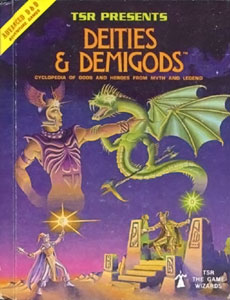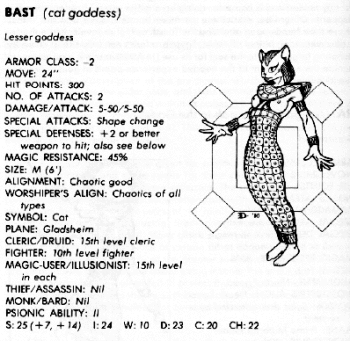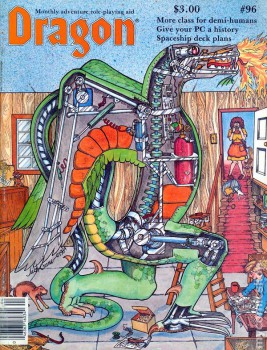Alignment Chaotic AWESOME: 1st Edition Deities and Demigods (Part 1)
 One of the most fun, crazy, and controversial tomes to come out of Advanced Dungeons & Dragons was, without a doubt, Deities and Demigods (1980).
One of the most fun, crazy, and controversial tomes to come out of Advanced Dungeons & Dragons was, without a doubt, Deities and Demigods (1980).
More wide-ranging (and less Eurocentric) than Bullfinch’s Mythology and Hamilton’s Mythology combined, here was a smorgasbord of most of the world’s major (and not-so-major) mythologies, presented as a one-stop shop for your player-character to choose a god or otherworldly entity to pledge fealty to and/r worship.
The vitriol of the religious right aside, Deities and Demigods did have its more thoughtful critics. In game terms, the early editions were kinda silly. Even though they assigned crazy-huge hit points and breathtakingly strong armor classes to the gods, said deities still had stats that could be overcome by powerful enough characters. As one critic observed, the book essentially turned the world’s deities into higher-level “monsters” to defeat — “bosses” for your 20th-level party to challenge. No room here for some metaphysical idea of a being that exists above corporeal, material reality and therefore cannot be “hurt” by a sword with a high-enough bonus modifier.
Later editions of Deities and Demigods (or Legends and Lore, as it was known for a time) ameliorated this “big boss” mentality by introducing the concept that some gods that characters physically encountered were but avatars, “aspects” or physical incarnations of gods who, being immortal and transcendent, could not really be killed.
That’s cool. Still, it is kind of fun — in a juvenile way — to leaf through Deities and Demigods asking such questions as “Who would win in a fight: Zeus or Odin?”

No wonder the fundamentalist Christians who condemned the game with bilious fervor back in the ‘80s heaped particular scorn on this volume. Yes, they were convinced D&D was turning children into devil worshippers, until Harry Potter came along and drew away their fire.
And here was proof! Children were selecting Bast (the Egyptian cat goddess) as a deity to worship! In truth, the only thing adolescent boys were worshipping was Bast’s catnips. (Okay, I’m going to hell for that one. The hell for bad puns.)
Of course, we’re talking here about fictional characters in an imaginary game-world, which most D&D players understood — but then, most of them probably had a better grasp of reality than the Christian fundamentalists. In the fundamentalist’s world, those “imaginary” gods are not imaginary at all, but covert disguises and nom de plumes for real demons.
Adding fuel to the fire (sometimes a literal bonfire at the local church youth group), D&D did directly appropriate one aspect of Judeo-Christian myth: the devils and demons (although they can be found in many other mythologies as well). Puritanical fear mongers took this and ran with it. (Can you imagine how many fuses would have blown if Deities and Demigods had included a section with stats for Adam and Eve, the angels Michael and Gabriel, and Jesus?)
I have devout memories of — as a pre-teen — perusing through my own copy, which I later learned was an expurgated version. I had owned the 1981 edition, a full 16 pages shorter than the original. Two whole sections of gods and supernatural beings had been omitted. Not that I would’ve cared much or particularly missed those specific gods when I was in sixth grade, but decades later, when I learned that one of those redacted sections was the Cthulhu Mythos, my curiosity was — to make a frank understatement — piqued.

And so I have spent months trying to procure my own copy of the original, without breaking the bank or giving my wife grounds to divorce me (or take away the checkbook). They do go for a pretty penny now. They are, in collectors’ parlance, highly desirable. Those unbowdlerized copies — the first printing of the first edition — can fetch well over a hundred dollars in nice condition (I’ve watched them do so on many an eBay auction of which I was not the winning bidder).
A couple months ago, I finally did obtain the rare version for $70. My curiosity about those missing sections made it worth the price, abetted by the rationalization that I could wring a blog post out of it. Then I thought about how Peter Jackson planned to do one Hobbit movie, went for two, and finally stretched it to three. So, in parts 2 and 3 of this series, I’ll provide a review of those missing sections. For those who may be planning to hunt down a copy, I’ll also impart some cautionary advice that I’ve learned firsthand (not all copies that claim to be the fabled first editions have the missing sections). I’ll let you know what specifically to look for in online listings — and it’s not the “Thank you” note on the copyright page acknowledging copyright holders for permission to include the Cthulhu and Melnibonean sections. The printing history of this book gets very tangled and misleading.
Oh, and Happy Easter! (That suddenly reminds me… One of my favorite Easter baskets was one the Bunny left me when I was elven eleven or twelve. Nestled among the sugary, marshmallowy confections were two issues of Dragon Magazine. Apparently, the Easter Bunny is also a role-player. Or, more likely, my mom asked me what I wanted for Easter that year and I provided a very specific list.)
Deities and Demigods has always been one of my favorite original AD&D books.
I always thought it was Loviatar that drew the interest of pubescent male players, since she is even more explicit than Bast (also, not a furry)
Some of the stats, though, were hilarious. Having a cleric of Bast whose wisdom outstripped her goddess is a hilarious concept.
Also having Bast live on Gladsheim is a bit … odd when you think about it. This was also one of my favorites, along with the original Manual of the Planes. I never owned the unexpurgated version, but at some point I got photocopies of the missing pantheons from a luckier friend.
“Can you imagine how many fuses would have blown if Deities and Demigods had included a section with stats for Adam and Eve, the angels Michael and Gabriel, and Jesus?”
Are you familiar with the infamous Dragon #28 (August, 1979) where Satan is given stats? It’s in a wild article called “The Politics of Hell.” I highly recommend its perusal for lovers of the original Deities and Demigods.
http://static.annarchive.com/files/Drmg028.pdf
For the longest time the Deities and Demigods book has been one of my favorites. Years ago I was talking to a friend about anther friend who accidentally lost my original! I was upset mainly because I tended not to lend out my D&D books. That friend told me he was selling off all his books but gave me his copy of the Deities and Demigods….and it was a first edition with the Cthulhu and Melnibonean pantheons!!!
@princejvstin: I had to go back and look up Loviatar: there she is, prominent on page 60. Goddess of Pain, indeed! Yep, I recall taking notice of her back in those days when the artwork for D&D was definitely PG-13. There were a few other goddesses that could’ve persuaded a young man to waver in his faith. (Another subject I should at least touch on in the next couple weeks is the artwork.)
“Also, not a furry.” ha!
@Joe H: Photocopies? yeah, that would’ve saved me a lot of money…
@James McGlothlin: I was not familiar with that article, but I’m sure glad you brought it to my attention. Stats for Satan — I’ve gotta see those! (I haven’t been able to check them out yet; my computer tells me Adobe Reader is blocked for that website. I think it’s probably something out-of-date on my laptop. Or God protecting me.)
@Chet Minton: Given what they’re going for, that was a generous gift!
[…] Alignment Chaotic AWESOME: 1st Edition Deities and Demigods (Part 1) […]